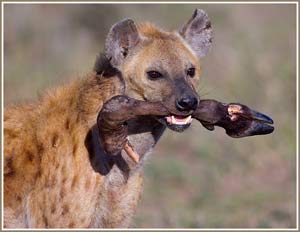Cannibalism often happens alone
Cannibalism is common in animals, including the ancient humans. Because the pathogen can jump from a victim to a predator, it can be deduced that the disease is easily spread among cannibals. But the reality is the opposite.
Illness rarely spreads among these animals. New calculations suggest that it is because they often eat separately. If you beat the herd, the germs will easily spread.
"Maybe that's why cannibalism is no longer popular in the past, because the huge negative effects can occur when the disease spreads," said ecologist Volker Rudolf from Dai. Virginia State University in Charlottesville (USA) said.
 (Photo: Birdsasart) Scientists know the diseases that are spread only or mainly through cannibalism. For example, Kuru is a mild form of brain degeneration in Papua New Guinea, a bit like mad cow disease, which only affects people who eat fresh meat.
(Photo: Birdsasart) Scientists know the diseases that are spread only or mainly through cannibalism. For example, Kuru is a mild form of brain degeneration in Papua New Guinea, a bit like mad cow disease, which only affects people who eat fresh meat.
Because cannibalism is common, Rudolf and his colleagues wanted to find out the extent to which this disease spreads. Scientific analyzes show that although mutual eating is encountered in many species, from crustaceans, insects to mammals, it seems that the disease spreads only in the following two cases: Kuru disease in humans and diseases Sarcocystis in lizards, in which this child eats the other's tail.
Calculations show that cannibalism will be an effective means of transmission only when the animals eat the cup together rather than being "alone".
"Such types of cannibalism are rare in nature," Rudolf said. "In addition to humans, the only other example we can find is chimpanzees, with groups of males attacking and eating other chimpanzees. It can be said that cannibalism is very common in the world, But usually one - eat - one ".
T. An
- Famous novelist predicts cannibalism
- Why do people eat people?
- Explaining the cause of human cannibalism
- Unearthing evidence of cannibalism in Germany
- Plague Buruli mysteriously spread in Australia
- Why is cannibalism unacceptable in humans?
- Species ancestors who once eat cannibalism
- Evidence of cannibalism discovered
- Tadpoles also eat cannibalism when food is scarce
- The plague
- Cannibalism helps rattlesnakes recover after birth
- Are prehistoric people happy to be eaten by their fellow humans?
 Animal 'suffering' after hibernation
Animal 'suffering' after hibernation Why do goats climb well?
Why do goats climb well? Scientists were surprised to see chimpanzees eating turtles
Scientists were surprised to see chimpanzees eating turtles Giant catfish died deadly due to drought in Thailand
Giant catfish died deadly due to drought in Thailand